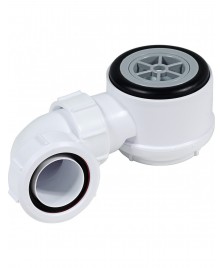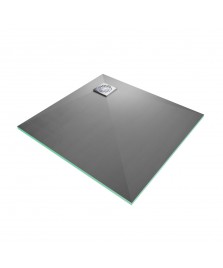- today
- perm_identity Chris Miller
- label Wet Room Kits
- favorite 0 likes
- remove_red_eye 1474 views

Clogged drains can be a real headache, especially when they occur in one of the most used spaces – the bathroom. More often than not, the culprit lies in the shower tray waste. Choosing the wrong size or type of waste can seriously disrupt functionality, ultimately causing frustrating clogs.
However, with careful planning and the right features, you can prevent clogs in your shower. It all starts with selecting the right wet room shower tray and waste.
Understanding Shower Traps, Types, and Uses
A shower tray waste, or a shower trap, is a crucial component of a shower system that connects the shower tray and the drainage pipe.
A shower tray waste fulfils the following essential roles:
-
Draining away the water from the shower tray efficiently, preventing water accumulation and potential overflow
-
Helping to prevent the buildup of debris in the shower tray, which can lead to clogs and other plumbing issues
-
Blocking unpleasant sewer gases from entering the bathroom
How Does a Shower Trap Work?
Shower traps act as a physical barrier against larger debris such as hair and soap scum. Their design allows water to flow through while trapping the unwanted matter. This prevents it from causing a clog deeper within the plumbing system.
At the same time, shower traps also create a water seal to block sewer gases from entering the bathroom. This seal is maintained by retaining water in a curved section of the trap, which is refreshed each time the shower is used.
What Are the Different Types of Tray Wastes?
There are several shower drain trap types, each designed to suit different types of showers and plumbing systems. The most common ones include:
-
P-traps and S-traps. Named for their shapes, these traps are designed to retain water to block sewer gases.
-
Shallow shower traps are designed for showers with low clearance.
-
Fast flow shower traps are ideal for power showers because they can handle a large volume of water.
-
Wet room shower traps are designed specifically for wet rooms and are typically low-profile with a high water volume capacity.
Tray Wastes: The Culprit Behind Most Drainage Issues
Most bathroom and wet room drainage problems can be traced back to improperly sized, positioned, or installed wastes. Common waste-related issues include:
-
Undersized wastes: Small grates with limited slots mean inadequate drainage capacity. Hair and debris quickly clog undersized wastes.
-
Oversized wastes: Large wastes on small trays look aesthetically unappealing. More importantly, oversized wastes on slimline trays can crack them due to weight and leverage pressures.
-
Bad positioning: Off-centre wastes affect water drainage. Water pools and leaks through poorly sealed areas instead of draining away efficiently.
-
Incompatible wastes: Failure to choose wastes suiting the tray model results in loose connections and leaks.
-
Cheap, low-quality wastes: Flimsy plastic grates, thin pipes, or basic traps easily get blocked, leak, or break.
Implications of Using the Wrong Shower Tray Waste
Drainage issues due to unsuitable wastes may seem like mere inconveniences initially, but minor clogs or leaks can spiral into huge problems if neglected. These include health hazards, plumbing emergencies, costly repairs, and reduced property value.
The inconvenience and costs involved make prevention the best cure. The key lies in investing correctly at the planning stage – choosing shower wastes correctly.
How to Choose the Right Shower Tray Waste
Selecting suitable shower wastes involves the following considerations:
Shower Waste Size
A range of shower waste sizes is available, and choosing the correct one is crucial to ensure stability and proper alignment with the tray.
Drainage Capacity
An important factor is ensuring the shower waste has adequate drainage capacity to handle the flow rate of the shower. High-water volume showers require a larger diameter waste to prevent water accumulation, while a smaller waste would suffice for low-flow showers.
Positioning
A centrally placed waste allows water to drain evenly from all sides for efficient shower tray drainage. Off-centre wastes can develop debris build-up on one side, leading to standing water in parts of the tray.
Easy Installation
Some types of wastes, such as push-fit or screw-down models, are easier to install than others, like solvent-weld options. Choosing a waste that's easy to fit can help prevent issues like leaks, cracks, and misalignments.
While many types of shower drains are available on the market, it's important to prioritise functionality over cost when making your selection. A well-chosen shower waste can enhance the performance of your shower and help prevent expensive problems down the line.
Combat Clogs with Wetroomstop’s Quality Shower Solutions
A clog-free bathroom starts from the ground up. An inadequate shower tray and waste can sabotage even the most gorgeous bathroom design. At Wetroomstop, we provide integrated solutions with our range of wet room shower trays and shower waste traps.
Combined with waterproofing and different types of shower drain supplies, our complete wet room kits offer peace of mind from leaks, odours, and costly plumbing emergencies.
Contact our team today to learn more about preventing clogs with our shower trays wastes.















